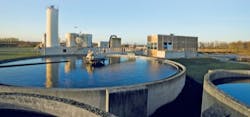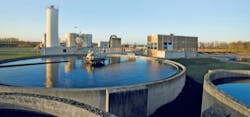Competitive Design-Build Procurement: Lessons Learned
By Tom Jacobs
In today’s tumultuous economy, cost saving and prudent capital project investments are increasingly important. But how does the largest city in a state plan for its future water supply while also cutting costs? The city of Wichita was faced with this dilemma, and thanks to insightful strategy, is saving more than $15 million on its new water treatment facility.
Project Overview
With a growing population of almost 400,000, the city of Wichita is the largest city in Kansas, and as such, needed to create a water supply plan for the next 40 years. In response to increasing water demands, the city’s water utility developed an integrated local water supply plan. The principle element of the plan, referred to as the Aquifer Storage and Recovery Project (ASR), is to restore and recharge the Equus Beds aquifer, which is used as the city’s main source of drinking water. Although the entire plan will take more than a decade to implement, the most recent phase demonstrated a few best practices of competitive, design-build procurement.
The Plan
A major phase of the ASR program was initiated in 2007. Once completed, this phase will include a 30 mgd surface water treatment plant, a 60 mgd river intake on the Little Arkansas River, a 60 mgd aquifer recharge and recovery system, 40 miles of overhead power transmission lines, and installation of about 30 miles of 16-inch to 72-inch pipeline. The project site is located 15-20 miles north of the city and encompasses an area of about 75 square miles. The city’s goal is to complete construction of the projects, estimated to cost around $230 million, and to begin aquifer recharge activities in the spring of 2012.
The Process
Due to the ASR program’s large scope and complexity, the city engaged the services of a program manager to provide the necessary procurement, design support, construction oversight, and negotiation support needed to deliver the ASR capital program on time and within budget. The program management team included R. W. Beck as the prime program manager, professional engineering consultants, and three major design consultants, CDM, CH2M Hill, and Burns & McDonnell.
As part of the design-build process, the program manager selected the design engineer for the surface water treatment plant project and oversaw the preliminary design and pilot testing activities. Following completion of the preliminary design, the program manager recommended the city open the procurement process to competition as a potential cost-saving strategy. After establishing selection criteria approved by the city council, the program manager led an open, design-build procurement process for the surface water treatment plant and river intake.
The program management team pre-qualified design-build contractors, prepared the design-build RFP, and administered the proposal review/interview process, which included an in-depth analysis of the price proposals received from the design-build contractors. As part of the selection process, the program manager pre-negotiated the agreement, general conditions and supplemental general conditions with the selected design-builders so all teams knew the terms of the contract they would have to sign prior to their price proposal submission. The price proposals received surprised both the city and the program management team.
The Proposals
As part of the surface water treatment plant preliminary design, the design engineer prepared a construction cost estimate of $95 million. When final design costs were added, the design-build estimate totaled $102 million. However, through the procurement process, the city received two additional design-build price proposals. An engineer-led team proposed $90 million, and a contractor-led team proposed $74 million — 21 percent below the engineer-led team and more than 28 percent below the construction estimate from the design engineer.
Such a large discrepancy between the price proposals caused considerable curiosity. Did the contractor-led team fully understand the scope of the project? Had it made a significant error or omission in its pricing?
To understand the discrepancy, the program manager review team conducted in-depth reviews of each price proposal, including meeting with the estimating teams to verify their assumptions and completeness supporting each price proposal. Production factors, unit prices, subcontracting methods and pricing, and labor costs were all reviewed and compared to industry standards. Major cost differences were determined to be in:
- Contingency
- Overhead and profit
- Electrical subcontracting
- Engineering costs
- Yard piping production
- Concrete production
After the in-depth review, the review team determined that the contractor-led team’s price proposal was complete, thorough and represented a reasonable price for the project as defined by the city. The general conclusion was that the contractor-led team tended to use forecasted costs and was more comfortable managing project risks than the engineer-led team, who used historical costs and was more risk averse. In addition, the tactic of obtaining competitive quotes for subcontracted elements as opposed to utilizing quotes from captive subcontractors yielded significant savings.
Figure 1: Preliminary architectural rendering of the City of Wichita’s ASR Phase II Surface Water Treatment Plant membrane filtration building.
Lessons Learned
Free-market competition ultimately will save the city at least $16 million, almost 38 percent below the initial estimated cost for the project. These significant savings are the result of the winning contractor offering a wide variety of delivery productivity and construction-cost–saving approaches. Free-market competition allowed the city to select a contractor on a best-value basis considering qualifications, cost, proposed scope and approach. The city learned several important lessons during this process.
Strategy Implementation
First and foremost, picking the right strategy is only the initial step. For a successful outcome, the strategy must be well implemented. As the city learned, a competitive procurement strategy can yield significant cost savings; however, careful planning is needed to garner the best results. For example, before any procurement process, it is important to get stakeholder buy-in. In Wichita’s case, the city established the selection criteria and was committed to whatever outcome before the competitive procurement began.
The Program Management Team
In addition, having a qualified program management team involved from the start is invaluable. It is the program manager’s responsibility to know the entire scope of the project and to be able to guide the city through decisions regarding price, scheduling, and the open procurement process. Wichita relied on its program management team throughout the process, from preliminary design through the procurement process and finally contractor selection and contracting.
The Right Expertise
Finally, having both technical and business expertise on the team is critical. The city depended on the program manager’s business acumen when planning the open procurement process. Once the city received proposals, it relied on their technical expertise to validate assumptions, review various pricing strategies, and ultimately verify that the pricing proposals were technically sound.
Next Steps
With the successful procurement process behind them, the city and program manager are now engaged in value engineering activities as the design of the plant is advanced to about 60 percent. At that point, the city and contractor will negotiate a Guaranteed Maximum Price, which must be less than or equal to $74 million, by the terms of the procurement process.
About the Author
Tom Jacobs is a senior management consultant in R. W. Beck’s Water Resources practice. With more than 33 years of industry experience throughout the Rocky Mountain region and central United States, he assists various public water and wastewater utilities with a variety of management-related issues. He is currently serving as the program manager for the city of Wichita’s ASR program.

